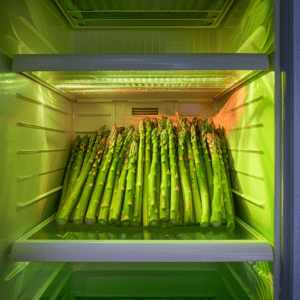How to store asparagus
The Asparagus Affair: An Introduction to Your New Favorite Veggie
Asparagus, known scientifically as Asparagus officinalis, is a spring vegetable that’s packed to the brim with goodness. Its bright, verdant stalks hint at its nutrient-rich composition. It’s a veritable cornucopia of vitamins including A, C, E and K along with essential minerals like folate and iron.
Additionally, it comes equipped with potent antioxidants that shield your body from harmful free radicals. Not only does asparagus bring a unique flavour and crunchiness to your dishes, but it also supplies your body with dietary fiber that aids digestion.
These slender green spears are indeed a powerhouse of health benefits waiting to be unlocked. But remember—they lose these nutrients quickly if not stored properly.
Maintaining Freshness: The Importance of Proper Asparagus Storage
Like many other fresh produce items, asparagus is quite delicate and demands proper care for maintaining its vivacity. Improper storage leads to wilting spears devoid of all their delightful crunchiness and vibrant taste—a sad sight for any veggie lover!
More importantly though, when not stored correctly you’ll end up losing the healthful properties of this wonderful vegetable. The key is understanding how to store asparagus in a way that preserves its freshness for as long as possible.
Whether you’re looking forward to grilling some tender stalks for dinner or planning on making a creamy soup later in the week—knowing how to properly store your asparagus can have profound effects on flavour profile and nutrient retention. Read on fellow foodies because we’re about to delve into the world of storing these delightful green spears in all their glory!
The Great Asparagus Debate: Fridge or Counter?
Refrigerated Relevance: The Chilly Facts of Fridge Storage
Let’s begin with the traditional method of asparagus storage – the refrigerator. From strawberries to celery, the fridge is often seen as a safe haven for our beautiful bounty. But does this cool cupboard truly offer the best environment for your asparagus?
Well, that honestly depends on several factors. Firstly, storing asparagus in the fridge offers a relatively controlled environment – away from direct light and heat which could degrade its quality swiftly.
It can also prolong your spears’ life span to a week if properly prepped (more on that later). However, it isn’t without drawbacks.
If not carefully wrapped or placed in an airtight container, asparagus can absorb odors from other foods in your fridge which could impact its taste and freshness adversely. Moreover, if left too long even under ideal conditions, asparagus may become limp and lose its crispness.
Countertop Charm: The Pros and Cons of Kitchen-side Storage
Moving onto our second contender – countertop storage! This method may seem eccentric to some; we don’t usually see veggies gracing our kitchen counters unless they’re bound for the cutting board soon. Yet, there’s something wonderfully aesthetic about standing up your asparagus spears in a jar with some water on your kitchen counter like lilies soaking up life-sustaining liquid.
The countertop approach indeed has its perks. It emulates how fresh-cut flowers are stored – upright with their cut ends in water – keeping them vibrant longer and it’s certainly an appealing sight.
This method keeps them at their best for 3-4 days typically. On the flip side however, countertops usually experience more temperature fluctuations than fridges, which could affect the asparagus’ freshness.
And let’s not overlook the exposure to light which might hasten their degradation. Not to mention, they could be in the way if you’re short on space or have a bustling kitchen.
The Fridge Method: Keep it Cool, Keep it Crisp

A Cool Refuge for Your Fresh Spears
Storing asparagus in the refrigerator is an excellent way to maintain its freshness and vitality. The cool temperatures of the fridge slow down the process of decay, keeping your asparagus sprightly and crisp. There’s an art to fridge storage though – just tossing your asparagus in there won’t do the trick.
Before we delve into specifics, let’s start with prepping your spears for their chill zone. Firstly, you don’t need to wash them before storing.
Counterintuitive as it might seem, this can actually promote spoilage by creating a damp environment that’s favorable for bacteria growth. Instead, wait until you’re ready to use them.
Prepping Your Spears for The Chill Zone
The first step in preserving their freshness is trimming the ends of your asparagus stalks – just like you would the ends of fresh flowers before putting them in a vase. This allows them to absorb water more efficiently and stay fresh longer. One common misconception is that all parts of asparagus are equal when it comes to staying power – not true!
The tips are actually more perishable than their stalky counterparts. So make sure they’re pointing upwards when stored; gravity will help keep moisture away from those delicate tips.
The Wet Paper Towel Trick
Wrapping Up Freshness
Why should burritos have all the fun? In this next step, we’ll be wrapping our trimmed asparagus stalks in wet paper towel — not too damp though!
It should be just moist enough but not sopping wet; balance is key here. Lay out a few sheets of paper towel that have been lightly moistened with cool water (again – no need for a towel-drenching soak).
Arrange your asparagus stalks on the wet towel and roll them up gently. The dampness of the towel will provide a humid environment, which helps keep asparagus fresh and crunchy.
Bagging Them Up Right
Sealing in the Flavor
Once your asparagus stalks are snugly rolled in their paper-towel cocoons, it’s time to give them an additional layer of protection — the humble plastic bag. Slip your wrapped asparagus into a perforated plastic bag – this creates an ideal storage environment that’s neither too dry nor too damp.
The little holes in a perforated bag allow excess moisture to escape, preventing water from accumulating inside the bag and causing your asparagus to become soggy or moldy. Remember: when it comes to preserving freshness, ventilation is just as important as hydration!
And that’s it! By prepping your spears correctly, using the wet paper towel trick, and bagging them up right, you can keep your asparagus crisp and delicious for longer periods in the refrigerator.
Countertop Storage: Asparagus in a Vase? Why Not!
A Step-by-Step Guide on Countertop Asparagus Storage
Have you ever considered treating your asparagus like a bouquet of flowers? If not, it’s time to start!
This method of storage not only adds an aesthetically pleasing touch to your kitchen but also keeps the asparagus fresh for longer. So, let’s delve into the simple steps involved in countertop asparagus storage.
First off, trim about an inch off the bottom of your asparagus stalks. This allows them to take in water more effectively.
Think of it like giving each stalk a little drink after its journey from farm to fridge to countertop. Now, take a tall glass or vase – clean and filled halfway with fresh water – and stand those spears up tall inside it.
Treating Your Asparagus Like Flowers
Nature has its poetry and here’s where we compose ours by treating asparagus akin to a bouquet of tantalizing tulips! Once those stalks are standing tall in their vase, cover them loosely with a plastic bag – this creates a little greenhouse effect that locks in moisture and keeps your asparag-bouquet hydrated.
Remember, just like flowers, it needs love (and by love we mean water). Change the water every 1-2 days or when you notice it starting to cloud over — remember that hydration is key for these delectable stems.
Water Level Watch-Out Tips
You may find yourself asking: how much is too much when it comes to watering our green friends? Well fret not! The answer is fairly simple; keep the water level about halfway up the stalks.
You don’t want your asparagus drowning, but you definitely want their bottom halves submerged. However, it’s crucial to keep an eye out for water discoloration.
If the water starts looking cloudy or murky, it’s time to change it out. Your asparagus deserves a clean and refreshing drink, just like us!
Temperature and Light Considerations
Temperature and light play a pivotal role in maintaining the verdant vitality of your asparagus. While these spears love basking in a cool environment, they are not fans of direct sunlight.
So, place them somewhere that remains consistently cool — think room temperature or cooler — but out of the path of direct sunlight. If all of these conditions are met correctly, this method will keep your asparagus fresh for up to a week!
Imagine that – seven days’ worth of delicious dinners with fresh asparagus straight from your countertop vase! This method ensures that every spear is firm, crisp and ready to be transformed into your favorite dish at a moment’s notice.
The Freezer Route: A Frosty Future for Your Favorite Spears
When the season of asparagus is upon us, it can be tempting to hoard these delicious green stalks. But alas, their freshness is fleeting!
This is where the freezer can become your trusted ally in your journey of asparagus preservation. Freezing asparagus for long-term use is a viable solution to enjoy its wholesome goodness year-round.
This method allows you to take advantage of those grocery store sales or abundant home harvests without worrying about quick spoilage. However, freezing these green gems requires a bit more preparation than the fridge or counter storage methods we’ve previously discussed.
Cleaning and prepping your greens for the big freeze: The Icy Initiation
Cleaning asparagus properly before freezing is crucial. Begin by gently washing your fresh spears under cold water to remove any residual dirt or pesticides, then pat them dry meticulously with a clean kitchen towel.
Your next step involves trimming. One horticultural conundrum many encounter – should I trim my asparagus before freezing?
If you’re dealing with tough, woody ends (usually in thicker stalks), it’s advisable to snip these off first. Trim about an inch from the bottom or snap them off naturally – you’ll feel where the tender part meets the woody stem during this process.
The blanching process explained: A Quick Dip Before The Big Chill
Blanching – it sounds like something out of a French culinary school textbook, doesn’t it? Fear not! It’s simpler than it sounds.
Blanching helms a twofold purpose; firstly, brightening our green buddies and secondly ensuring enzyme activities that cause loss of flavor and nutrients are put on pause. Blanching entails boiling your spears for a brief time period (two to four minutes depending on their thickness) followed by an immediate plunge into icy water to halt the cooking process.
Once blanched, lay your asparagus in a single layer on a baking sheet and pop it into the freezer just until firm. This trick prevents them from freezing together into one big ‘asparaberg’.
Packaging tips for freezer-friendly veggies: Ice Age Asparaguidance
Now that you have pretreated your asparagus spears, they are ready for their long slumber in the icebox. But before you simply toss them in willy-nilly, heed this advice: packaging is pivotal! Vacuum sealing is an excellent way to prevent freezer burn and extend shelf life, but if you don’t own a vacuum sealer, fret not!
Freezer bags work wonders too. Ensure all air is expelled from the bag before sealing – you can use the straw method or the water displacement method for this.
Label each package with the date of freezing so that you can keep track of how long they’ve been stored. Remember, properly stored frozen asparagus can maintain top quality in your freezer for about eight to twelve months, though they’ll stay safe to eat indefinitely if kept at 0°F.
Asparagus On-the-Go: Travel Tips with Your Favorite Veggie Friend
Your Asparagus Roadtrip Companion: How to Pack for Success
Let’s imagine a scenario: you’re headed out on a weekend camping trip or maybe an extended vacation. You’ve fallen in love with the taste and health benefits of including asparagus in your meals. You’d like to take it with you, but how do you keep it fresh during your travels?
The good news is, those succulent spears travel much better than one might expect. If kept away from excessive heat, asparagus can maintain its freshness for a few days without refrigeration.
The most effective way to pack them for transit is to dampen some paper towels and wrap them around the bottom halves of the asparagus bundles, just like storing them in the fridge. Next, place them inside a resealable plastic bag but don’t seal it entirely; leave it slightly open so that some airflow is possible.
Transit Freshness 101: Keep Your Spears Sprightly
Maintaining freshness during transit depends on various factors like temperature control and managing water loss from the vegetables. It’s essential to avoid exposing your asparagus to high temperatures or direct sunlight during transit—both of these conditions can cause wilting and deterioration.
Also remember that moisture is both friend and foe here—it’s necessary for keeping your asparagus fresh but too much can lead to rotting. So, check the dampness of paper towels wrapped around your veggies at regular intervals; rewet if they’ve dried up or replace if they’re too saturated.
Last but not least, when you reach your destination—especially if it’s a campsite without any refrigeration—try using nature’s fridge by digging a hole in cool earth, placing your veggie pack inside and covering it back up with soil. This will help maintain a cool temperature and keep your asparagus fresh for longer—ready to roast over the fire or toss in a pan with some butter and garlic right at your campsite.
Remember, even as you travel, you don’t have to forego the joy of munching on your favorite green sticks. How’s that for living life on the spears’ edge?
Conclusion: Embrace Your Inner Asparaguardian!
Reminiscing the Green Path
Over the course of our journey together, we’ve learned that asparagus isn’t just a nutritious and delicious veggie, but also one that requires careful handling to maintain its freshness. We dived into the great debate on whether these green spears should be relegated to the refrigerator’s chill or treated like floral arrangements on your kitchen countertop. Both methods have their merits and demerits—where fridge storage promises longevity, countertop technique offers quick-access convenience.
We also embarked on a freezing adventure with our beloved asparagus. We learned how preparing, blanching and correctly packaging these slender stalks can help us sustain our asparagus cravings even in off-seasons.
And who knew that even trips or camping excursions could become gourmet experiences? Yes, we discovered how to securely pack our green friends for transport so they stay fresh throughout the journey.
Becoming an Asparaguardian: Experimentation is Key
The beauty of these methods is they are not set in stone—there is always wiggle room for experimentation. Perhaps your fridge’s humidity level allows for slightly tweaked storage technique; maybe your sunny kitchen counter necessitates a different water change schedule than suggested.
The key takeaway here is to maintain an attentive eye on your stored asparagus, making adjustments according to its response. Perhaps you live in warmer climes and freezing becomes advantageous beyond just long-term storage; maybe you’re an avid camper looking for smarter food packing techniques—you have all the tools at your disposal now!
The Asparaguardian Chronicles: A Happy Ending
At last, dear reader, we finish this exploration of asparagus preservation with more knowledge than when we started—and hopefully with a renewed passion for this mighty veggie! No longer will wilted stalks or wasted produce haunt our veggie drawers.
Instead, we emerge as triumphant Asparaguardians, ready to enjoy fresh asparagus at our whim and fancy. Here’s to many a splendid dish starring our favorite green protagonist—cheers to us, the enlightened Asparaguardians!



